Katy J Chamberlain* is investigating zoned pyroclastic airfall deposits on Ascension Island with help from a Society Fieldwork Grant.
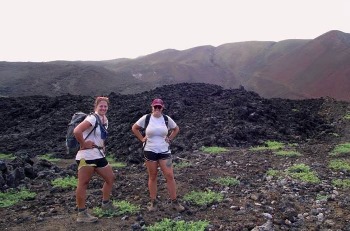 Ocean island volcanoes, unrelated to clear tectonic boundaries such as rifts or subduction zones, are intriguing examples of ‘intraplate volcanism’. While magmatic sources and plumbing systems on ‘classic’ ocean island volcanoes like Hawaii, Iceland and Tenerife are relatively well understood, they also highlight the surprising range of mantle sources - and magmatic evolution processes – that can be detected in these isolated locations.
Ocean island volcanoes, unrelated to clear tectonic boundaries such as rifts or subduction zones, are intriguing examples of ‘intraplate volcanism’. While magmatic sources and plumbing systems on ‘classic’ ocean island volcanoes like Hawaii, Iceland and Tenerife are relatively well understood, they also highlight the surprising range of mantle sources - and magmatic evolution processes – that can be detected in these isolated locations.
Picture, left: Katy Chamberlain (l) and Holly Connolly (field assistant, r) on the lava fields of Ascension.
Understanding ocean-island volcanic processes is important, not only to help forecast and potentially mitigate hazards from future eruptions, but as a test-bed for viable mechanisms whereby felsic continental crust can be generated on thin, mafic ocean crust.
Ascension Island is a small (12km diameter) ocean island volcano in the tropical South Atlantic, 90km west of the Mid Atlantic Ridge, with a population of c.800. The island is a unique place, accessible only by taking one of the 10 civilian seats on a twice-weekly Air Tanker flight from RAF Brize Norton to the Falkland Islands. This flight stops at Ascension to change flight-crew and deposit supplies for the RAF base.
Unique
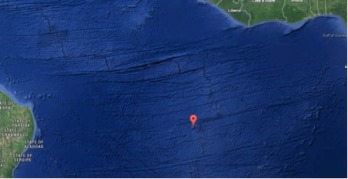 Picture, right: Location of Ascension Island (Google Earth)
Picture, right: Location of Ascension Island (Google Earth)
Volcanologically, the island is unique, with almost every type of volcanic deposit present in its 96 square kilometres. While most Ascension residents live on the lower mafic lava fields dotted with scoria cones in the western areas of the island, higher ground in the central and eastern areas boast felsic lava flows, domes, scoria fall, pumice fall, pyroclastic flow and debris avalanche deposits - with a complete range in magma compositions from mafic olivine-basalts through to felsic trachytes and rhyolites. Previous work on the island has focused on geochemistry, resulting in reasonably detailed geological maps which display units based on their composition rather than stratigraphic relationships.
We undertook a field trip to Ascension Island during July 2014 with the aim of quantifying the range of eruption styles and sampling their deposits. But during this work two unusual zoned fall deposits were identified, showing variation between scoria and pumice during the course of a single eruption. These two fall deposits vary in the way that they change from pumice to scoria, potentially representing different modes of formation.
We have chosen to investigate these deposits in detail because there is a chance that the preservation of the scoria-pumice transition has captured a magmatic process that has not yet reached completion (unlike in the other, unzoned pumice-fall deposits). We therefore applied for a Geological Society Fieldwork Grant to return to Ascension to carry out detailed observations of these two deposits, and to sample them fully in order to understand the geochemical processes responsible for felsic magma genesis at Ascension Island.
2015 field season
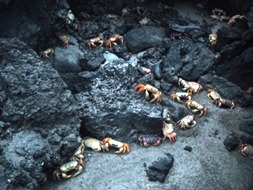 Picture, left: Land crabs at NE Bay
Picture, left: Land crabs at NE Bay
We undertook ten days of intensive fieldwork in mid-2015, to place these zoned fall units in stratigraphic context with all the other eruptive units on the island. We also took detailed, centimetre-scale stratigraphic logs through the units, to capture compositional and textural variations, variations in maximum juvenile and lithic clast sizes (with both stratigraphic height and lateral variations), unit thickness, and the nature of bounding stratigraphic units. This allowed the variation within subunit thickness, and maximum pumice and lithic sizes, to be measured and compared across a wide area.
Fieldwork on Ascension Island comes with its own unique challenges, not least being its isolation. St Helena is the nearest landmass to Ascension Island, and that is still nearly 1300km away! The island has only 40km of roads, so most of our fieldwork involved wandering across the trackless terrain on foot. Luckily no animals more dangerous than the ever-present land crabs are hiding in the undergrowth. We spent many hours discussing the possibility of teaching these land crabs to use their claws for good - and pre-crush some pumice for us. Sadly, neither of us dared get close enough to assess whether the full force of their (up to 40-year old) pincers might be sufficient for the task.
Fractionation?
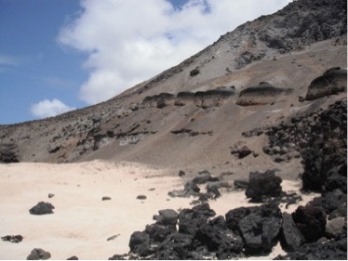 Picture, right: The compositionally zoned fall deposit at North East Bay outcropping underneath a thick trachytic lava flow.
Picture, right: The compositionally zoned fall deposit at North East Bay outcropping underneath a thick trachytic lava flow.
The compositionally-zoned fall is found only in the north eastern, younger, areas of the island, and is the best preserved eruption in all of Ascension Island’s history. Previous studies have dated the overlying trachyte lava to be 163,000 years old1, so we expect this eruption to be of about the same age, but a little older. While it is the best-preserved eruption deposit on the island, the geographic area of outcrop meant that no meaningful isopachs could be drawn, and therefore, no eruptive volumes estimated.
Luckily, while exploring the coastal areas, we were able to identify the vent site for the compositionally-zoned fall by noting the presence of a fissure with bomb-sized clasts of the deposit in its walls (picture). The logs through the compositionally-zoned fall deposit show a systematic gradation - from more-evolved, creamy pumice at the base through to slightly less-evolved, light brown pumice in the middle of the unit, to the least-evolved brown scoria at the top.
Chemical analyses of samples collected have revealed that the whole-rock compositions change systematically with stratigraphic height, but with no evidence in their crystal chemistry for multiple magma compositions. Therefore, this fall deposit is thought to be the result of the evacuation of a chemically-zoned magma chamber, which became more felsic in composition by closed-system fractionation.
Magma mixing
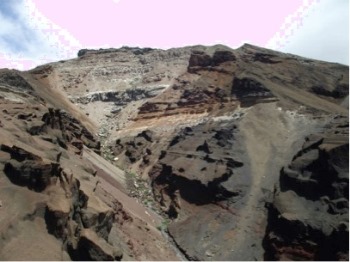 Picture, left: Fissure vent for the compositionally-zoned fall deposit, overlain by a younger trachyte lava flow at the head of the fissure.
Picture, left: Fissure vent for the compositionally-zoned fall deposit, overlain by a younger trachyte lava flow at the head of the fissure.
In contrast to this compositionally-zoned fall, the much older mingled fall (picture) is not found to crop out in many locations, and is restricted to the island’s central area. The mingled fall changes rapidly from pumice to scoria over a sharp boundary, with no transitional clasts identified. Although this deposit is not found in many places on the island (and thus we could not draw isopach maps to locate the vent site, or calculate the volume of magma erupted), we did derive insights into the origins of the mingled fall.
We discovered multiple lines of evidence for mixing between the felsic, pumice-producing magma, and much less-evolved mafic, scoria-producing magma: including mixed clasts, bimodal crystal and melt inclusion compositions, and chemical zoning on the felsic-sourced crystals. We therefore interpret this deposit as the result of a late-stage, potentially eruption-triggering, magma mixing event between a felsic and a mafic magma.
Future work
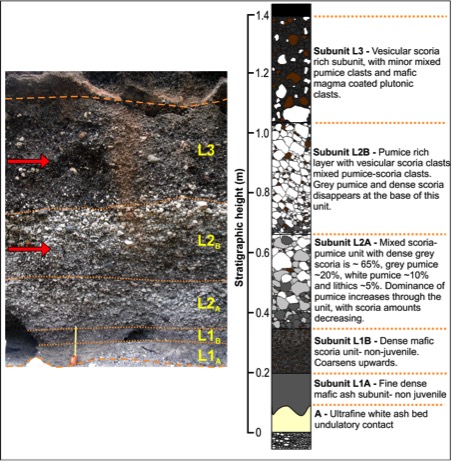 These contrasting, well preserved zoned fall deposits on Ascension highlight the contrasting magmatic processes responsible for generating felsic magmas, and their interaction with mafic lavas also common on the island. The apparently closed-system evolution of the compositionally-zoned fall raises the question of whether more felsic fall deposits on Ascension are compositionally-zoned, but do not cross the pumice-scoria textural boundary. Further work is required to understand how the magmatic processes, identified in the zoned deposits, relate to texturally unzoned deposits on the island.
These contrasting, well preserved zoned fall deposits on Ascension highlight the contrasting magmatic processes responsible for generating felsic magmas, and their interaction with mafic lavas also common on the island. The apparently closed-system evolution of the compositionally-zoned fall raises the question of whether more felsic fall deposits on Ascension are compositionally-zoned, but do not cross the pumice-scoria textural boundary. Further work is required to understand how the magmatic processes, identified in the zoned deposits, relate to texturally unzoned deposits on the island.
Diagram, right: The mingled fall deposit, showing the bimodal clast type present in the deposit; red arrows indicate sampling horizons.
The role of the closed-system crystal fractionation is unusual for an ocean island, where commonly, multiple magma types are known to interact. Yet, Ascension Island is known to have a relatively low magmatic flux2 compared with other classic ocean islands, and it is possible that this has an effect on the types and timescales of the magmatic processes responsible for felsic magma generation, and therefore potentially significant implications for the genesis of continental crust.
References
- Jicha, B. R., Singer, B. S., & Valentine, M. J. (2013). 40Ar/39Ar Geochronology of Subaerial Ascension Island and a Re-evaluation of the Temporal Progression of Basaltic to Rhyolitic Volcanism. Journal of Petrology, 54(12), 2581-2596.
- Minshull, T. A., Ishizuka, O., & Garcia‐Castellanos, D. (2010). Long‐term growth and subsidence of Ascension Island: Constraints on the rheology of young oceanic lithosphere. Geophysical Research Letters, 37(23).
* Dr. Katy J. Chamberlain, Postdoctoral Research Associate, Department of Earth Sciences, University of Durham, Durham, DH1 3LE, UK E: [email protected].
If you would like to apply for fieldwork support money from the Society, please go to W: www.geolsoc.org.uk/grants.
Save